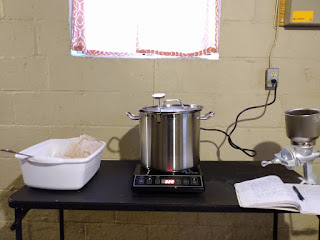The famous beer writer Randy Mosher once wrote in his book
Radical Brewing that "There are magicians who can coax well-milled malt from a Corona-style mill, but they are rare." Well call me a magician, Mr. Mosher. There's nothing wrong with these babies, and there's something about hand cranking that feels more fitting for this labor of love known as homebrewing. Drills are fast, and it makes sense to use them, especially at a homebrew shop or when you're whipping up a 10 pounds-plus all-grain batch, but when I'm only milling a couple pounds at a time at best, I've got a crush on a Corona mill.
It takes a few tries to find the right setting with these mills. After all, they're made for milling grains into flour. Tighten the knob too much and you've got the ingredients to make bread. But if you'll twist it back just a little bit, crank a few times and inspect your work, you're on the right path. My rule is so simple it's stupid: if your milled grains look very similar to whole grains, you don't have the right crush (like the picture below).
If they look very different from whole grains, but not a floury mess, you've found it. I'm about to get real unscientific here, but notice the hard white pieces of the grain in the picture below this paragraph. There's a lot more in this crush than the one before. That to me is a good sign that I've done it right and the grain will yield high efficiency.
For a 3.25 gallon batch, I milled 4 ounces of 2-Row and 8 ounces of Crystal 60. The rest of my fermentables came from liquid extract. I took a Charlie Papazian recipe from
The Complete Joy of Homebrewing (3rd Edition) called "Palace Bitter" and modified it as a 30 minute boil, partial-mash recipe with a few adjustments to the hop schedule using
BrewTarget. For the yeast, I used a popular English strain, US-04. Here's a look at the recipe:
Palace Bitter - Special/Best/Premium Bitter (8B)
================================================================================
Batch Size 3.25 gal
Boil Size 2.5 gal
Boil Time 30.000 min
Efficiency 70%
OG 1.042 sg
FG 1.011 sg
ABV 4.2%
Bitterness 26.8 IBU (Tinseth)
Color 9.8 srm (Morey)
Fermentables
================================================================================
Name Type Amount Mashed Late Yield Color
Briess - Pale Ale (LME) Extract 2.300 lb No No 78% 6.0 srm
Briess - Pale Ale (LME) Extract 1.000 lb No No 78% 6.0 srm
Caramel/Crystal Malt - 60L Grain 8.000 oz Yes No 74% 60.0 srm
Briess - 2 Row Brewers Malt Grain 4.000 oz Yes No 80% 1.8 srm
Total grain: 4.050 lb
Hops
================================================================================
Name Alpha Amount Use Time Form IBU
Fuggles 4.7% 0.400 oz Boil 30.000 min Pellet 9.1
Kent Goldings 4.7% 0.400 oz Boil 30.000 min Pellet 9.1
Fuggles 4.7% 0.250 oz Boil 15.000 min Pellet 3.7
Kent Goldings 4.7% 0.250 oz Boil 15.000 min Pellet 4.3
Kent Goldings 4.7% 0.300 oz Boil 2.000 min Pellet 0.7
Yeasts
================================================================================
Name Type Form Amount Stage
Safale S-04 Ale Dry 0.39 oz Primary
Notes
================================================================================
Joy of Homebrewing (3rd edition) by Charlie Papazian.
I'm doing a 30 minute mash (with the addition of 2-row) and a 30 minute boil.
My plan is to let this sit in the primary bucket for 10-14 days, bottle and prime for another 2 weeks. I'm expecting an amber colored beer that's balanced and very sessionable. Given all the science-based skepticism of late hopping in favor of whirlpool hopping (below 180 degrees F) that I've been reading lately, I'm curious as to just how much aroma I'm going to get from this brew, but only time will tell a lie. I'll post a picture or two of the brew in a glass when it's ready.
 Last month I brewed a Marzen on MLK Day which I'm calling Martin's Marzen. Yesterday I brewed a lager for the second time. It's a German pilsner based upon the recipe from Randy Mosher's Radical Brewing titled Polka Dot Pilsener, with a few variations. Let me explain.
Last month I brewed a Marzen on MLK Day which I'm calling Martin's Marzen. Yesterday I brewed a lager for the second time. It's a German pilsner based upon the recipe from Randy Mosher's Radical Brewing titled Polka Dot Pilsener, with a few variations. Let me explain.

















